In the fall, hundreds of thousands of birds travel through Central Texas. Many of them are heading south for the winter. Texas is a popular wintering destination for birds, both migratory and non-migratory. Many birds spend their winters in Texas.
Texas is in the Central Flyway, which is a bird migration route for migratory birds. It follows the Great Plains in the United States and Canada. Birds use these routes because no mountains or large hills are blocking their flyways. They can also find good sources of water, food, and shelter over the entire Central Flyway.
Even though the birds on this list live in Texas year-round, it might be easier for you to spot them during the winter when migratory bird species have traveled south.
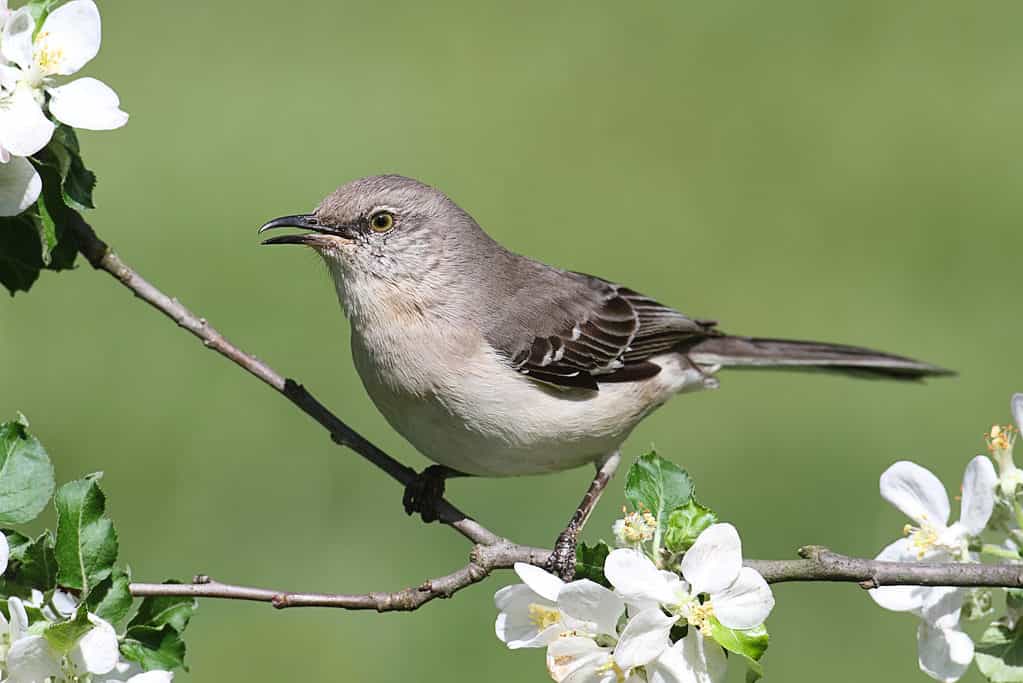
The northern mockingbird is the state bird of Texas.
©Steve Byland/Shutterstock.com
1. American Crow
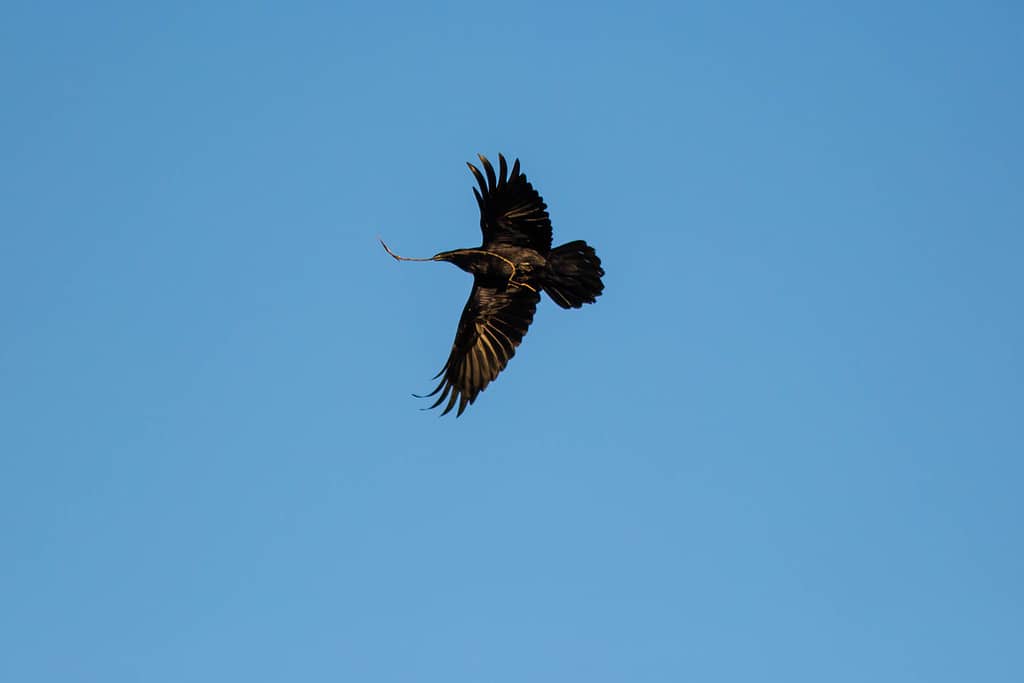
American Crow looking for prey to catch.
©Melissa McMasters from Memphis, TN, United States / CC BY 2.0 – Original / License
The American Crow (Corvus brachyrhynchos) spends its winters in Texas and is a resident bird of the state. It is a highly adaptable bird found in various habitats throughout Texas and across North America. They also live in Canada, Europe, Asia, the Middle East, Africa, and Australia. They reside in a variety of habitats including forests, open fields, and even cities. American crows are adaptable to living in temperate climates.
American crows are known for their resourcefulness and intelligence. You can easily spot an American crow by seeing its solid black feathers or hearing its distinct ‘caw’ sound. These crows also coo and rattle. Also, they have a wingspan of 36 inches! It is common to see them flying over open areas including fields and grasslands. American crows are omnivores that eat everything from insects to seeds.
It is easy to spot an American crow in Texas during the winter months.
2. Carolina Chickadee
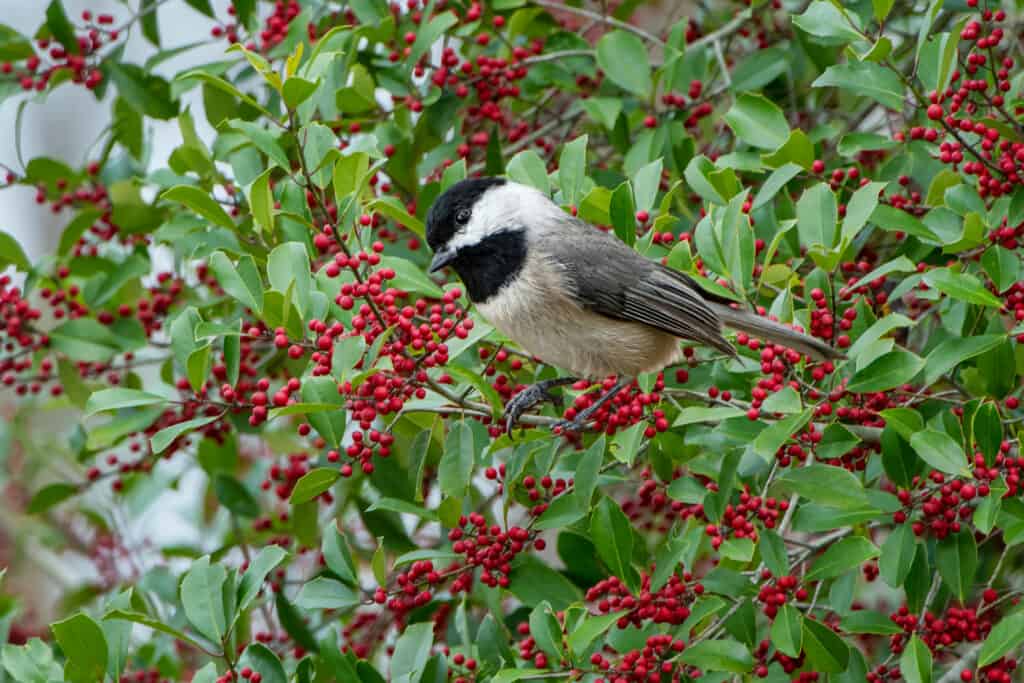
Carolina chickadees are the smallest chickadees in North America.
©Bonnie Taylor Barry/Shutterstock.com
It is common to see the Carolina chickadee (Poecile carolinensis) spending its winters in Texas. Carolina chickadees live in the state all year round.
They are small, non-migratory birds that live all over the United States including in the Carolinas, Georgia, Alabama, Mississippi, and Tennessee. They live in a variety of habitats including wooded and forested habitats, woodlands, pine forests, and even suburban areas. Typically, though, they nest in tree cavities or birdhouses, often choosing dead or decaying trees for their nesting sites.
They are known for their distinctive “chick-a-dee-dee-dee” call and are often found in pairs or small groups foraging for insects, seeds, and berries. They are the smallest chickadees in North America.
In general, Caroline chickadees tend to live in the southeastern United States, while the very similar Black-capped chickadees are much more commonly found in the north. The Black-capped chickadee is the state bird of Massachusetts.
Carolina chickadees and Black-capped chickadees look alike. However, the wings of Carolina chickadees have a little bit more brown in them. Also, Carolina chickadees have a longer call of four syllables, while Black-capped chickadees have a two-syllable call.
3. Eastern Bluebird

You can feed bluebirds live or dried mealworms in a feeder.
©Alan B. Schroeder/Shutterstock.com
The Eastern bluebird (Sialia sialis) spends its winters in Texas. It is a year-round resident of the state and is typically seen during the winter in suburban and rural areas.
These beautiful little birds have no trouble living among human beings. They do not hesitate to build a nest in a birdhouse provided for them. As a thank you to humans who provide their shelter, Eastern bluebirds eat insect pests.
A funny fact about Eastern bluebirds is that they are not blue. Their blue coloration is a trick of the light. They merely appear blue.
Birdwatchers love to spot Eastern bluebirds because they are conspicuous and generally pretty easy to find – especially in Texas, where they spend their winters! These birds love to perch atop a fence or a telephone wire.
4. Great Horned Owl
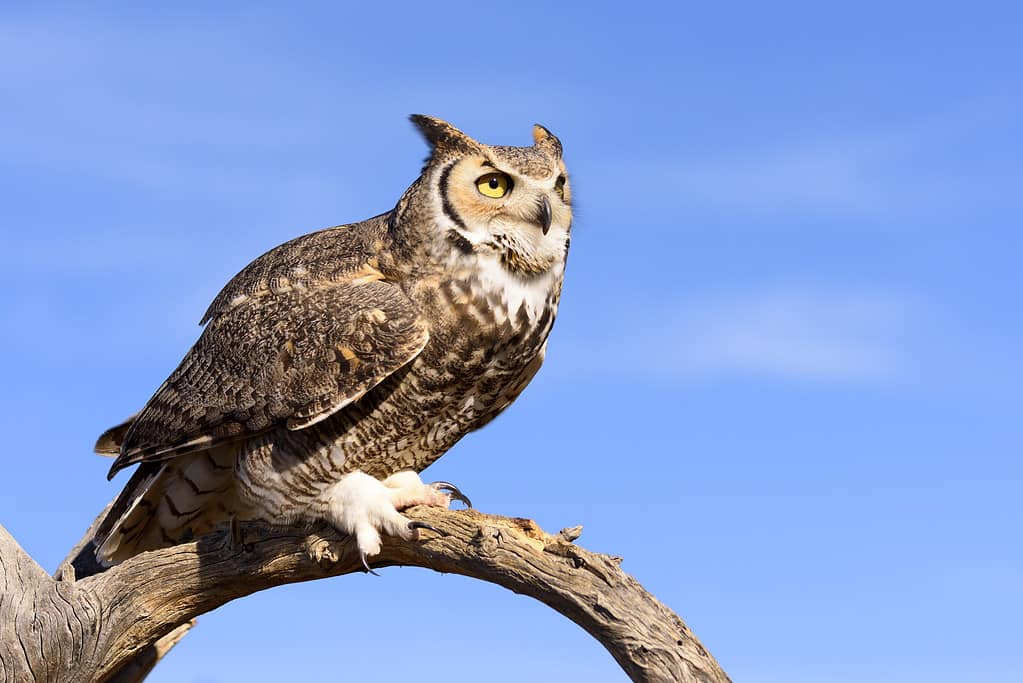
Great Horned Owls spend their winters in Texas.
©kojihirano/iStock via Getty Images
The Great horned owl (Bubo virginianus) lives full-time in Texas so, of course, it spends its winters in Texas! This large and powerful owl lives in various locations throughout North and South America. They are highly adaptable so they live in a variety of habitats including forests, grasslands, deserts, and even cities.
Great horned owls are known for their massive wingspan of up to five-and-a-half feet! And they can weigh between two to five-and-a-half pounds! They do not have horns, but rather, feather ear tufts. They are used for communication rather than for hearing.
The great horned owl is a carnivorous bird and a hunter. It feasts on rodents, other birds, rabbits, and skunks. Because of its talons and beak, it can take down larger prey for a meal. They do most of their hunting during the night, with excellent vision and hearing.
One of the coolest facts about great horned owls is that they can live in the wild for up to 15 years!
5. Northern Cardinal

Some northern cardinals mate for life.
©Bonnie Taylor Barry/Shutterstock.com
The northern cardinal (Cardinalis cardinalis) is a year-round resident of Texas. This mid-sized songbird is also referred to as a cardinal, a red cardinal, a common cardinal, and a redbird.
It lives across North America and South America in wetlands, shrublands, woodlands, and gardens.
The northern cardinal is a mid-sized songbird characterized by its raised crest and bright beak featuring a coral color. It measures 8.3-9.3 inches in body length with a wingspan of 9.8-12.2 inches. Males are a cardinal red color and females are olive-brown with red accents; males are also somewhat larger in length and weight than females. Adults weigh 1.19-2.29 ounces with an average weight of 1.58 ounces. Because of their bright colors, they conceal their nests in dense trees and shrubs.
A fun fact about northern cardinals is that many of them mate for life!
Indeed, if you are in the Lone Star State during the winter, you can easily spot a northern cardinal.
6. Mourning Dove
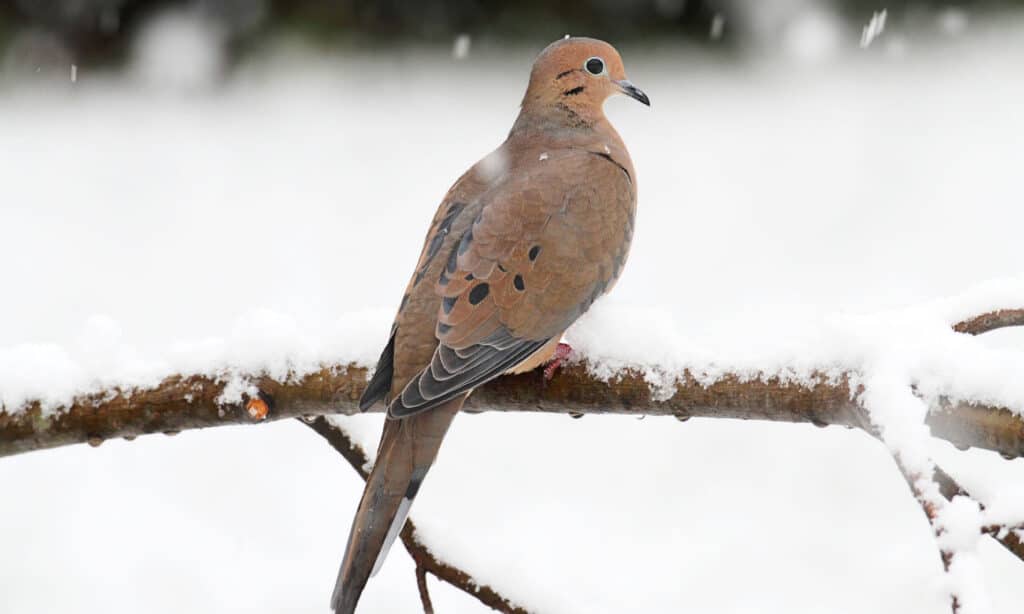
Mourning doves spend their winters in Texas.
©iStock.com/SteveByland
The mourning dove (Zenaida macroura) spends its winters in Texas, as well as every other season throughout the year. It is one of the most common birds in North America. It is famous for its easily recognizable silhouette, its mourning call, and its symbolism of peace, grief, loved ones, friendship, companionship, and other meaningful themes.
One of the most interesting facts about mourning doves is that their “cooOOoo-woo-woo-woooo” calls are often mistaken for the calls of an owl! If you are in Texas in the winter, listen carefully so that you can spot a mourning dove.
7. Northern Bobwhite

The northern bobwhite is a small quail species.
©Wilfred Marissen/Shutterstock.com
If you are in Texas in the winter, you can easily spot a northern bobwhite (Colinus virginianus). You just have to listen closely for the whistling call that sounds like ‘bob-white,’ which is where this bird gets its name.
The northern bobwhite is a small quail species, measuring about 9 to 10 inches in length. These birds typically have a wingspan of about 13 to 15 inches.
The northern bobwhite is a non-migratory bird species, only existing in year-round populations. It is native to the western hemisphere, specifically North America. Outside of the United States, its largest population is in Mexico. So, it makes sense that it is easy to spot one in Texas in the winter!
8. Northern Mockingbird

Northern Mockingbird pair perched on branches against a bright blue sky.
©Chris Klonowski/Shutterstock.com
The northern mockingbird (Mimus polyglottos) is the state bird of Texas, where it lives year-round, including in the winter. It is a popular bird: four other states have also chosen it as their state bird. Those states include Arkansas, Florida, Mississippi, and Tennessee.
They live in a variety of habitats. Northern mockingbirds prefer to stick to forest edges rather than live deep within dense forests. They also live in farmland, wild spaces, and even urban areas. The northern mockingbird hangs out along fencerows and in grasslands with shrubs. They like to frequent farms with open pastures and nearby wooded areas. And they also reside in parks and neighborhoods, especially with abundant berry-producing shrubs, bushes, or trees.
Northern mockingbirds are known for their frequent singing. Males mimic everything from other birds to machinery, and they can build a repertoire of up to 200 different songs. Males sing more often than females, and unmated males will often sing through the night, especially during mating season.
However, even outside of the mating season, you can spot a northern mockingbird as it spends its winters in Texas.
9. Red-tailed Hawk
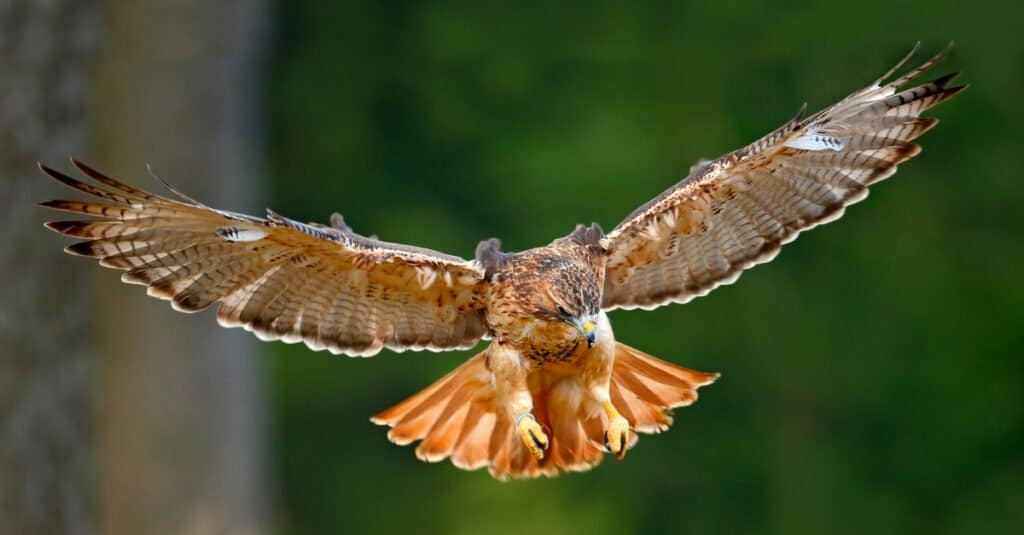
The red-tailed hawk isn’t particularly dangerous to people, but it is a vicious and relentless hunter that might prey on puppies or kittens and poultry like chickens.
©Ondrej Prosicky/Shutterstock.com
Throughout the year, including in the winter, you can see a Red-tailed Hawk (Buteo jamaicensis) in Texas. It also lives all over North America, including in Alaska! It lives in a variety of environments from forests to cities and grasslands to deserts. They eat rodents like mice, rabbits, moles, and squirrels, as well as birds, snakes, and large insects. You can spot them soaring high in the sky as they search for their next meal.
Red-tailed hawks are known for their fierce calls. They are also known for their longevity: they can live up to 15 years in the wild.
In the winter, you might see these hawks in Texas.
10. White-winged Dove

White-winged doves live in Texas year-round.
©Wingman Photography/Shutterstock.com
The White-winged Dove (Zenaida asiatica) spends its winters in Texas, mainly residing in the southern and eastern parts of the state. You can spot a White-winged dove by noticing its plump body, about the size of a robin, with square tails and long, thin bills. Its body is brown with dark wings, white stripes, and a white mark on its tail. Its face also has distinctive markings, including a blue hue around its eyes and a black line across its cheeks.
This dove prefers habitats in the Southwestern United States, like in Texas, and is increasingly appearing in urban and suburban areas. It likes to eat at feeders in backyards. It also forages for seeds on the ground and perches in trees eating berries. These birds can fly 25 miles or more just to find water.
You can also spot White-winged doves in Texas throughout the year, including in the winter.
| Texas Winter Bird | Scientific Name | Fun Fact |
|---|---|---|
| American Crow | Corvus brachyrhynchos | It has a wingspan of 36 inches. |
| Carolina Chickadee | Poecile carolinensis | They are the smallest chickadees in North America. |
| Eastern Bluebird | Sialia sialis | They are not really blue. |
| Great Horned Owl | Bubo virginianus | Their wingspan measures up to 5.5 feet. |
| Northern Cardinal | Cardinalis cardinalis | Many of them mate for life. |
| Mourning Dove | Zenaida macroura | Its calls are often mistaken for the calls of an owl. |
| Northern Bobwhite | Colinus virginianus | Its whistling call sounds like ‘bob-white,’ which is where it gets its name. |
| Northern Mockingbird | Mimus polyglottos | It is the state bird of Texas. |
| Red-tailed Hawk | Buteo jamaicensis | They can live up to 15 years in the wild. |
| White-winged Dove | Zenaida asiatica | These birds can fly 25 miles or more just to find water. |
Thank you for reading! Have some feedback for us? Contact the AZ Animals editorial team.








